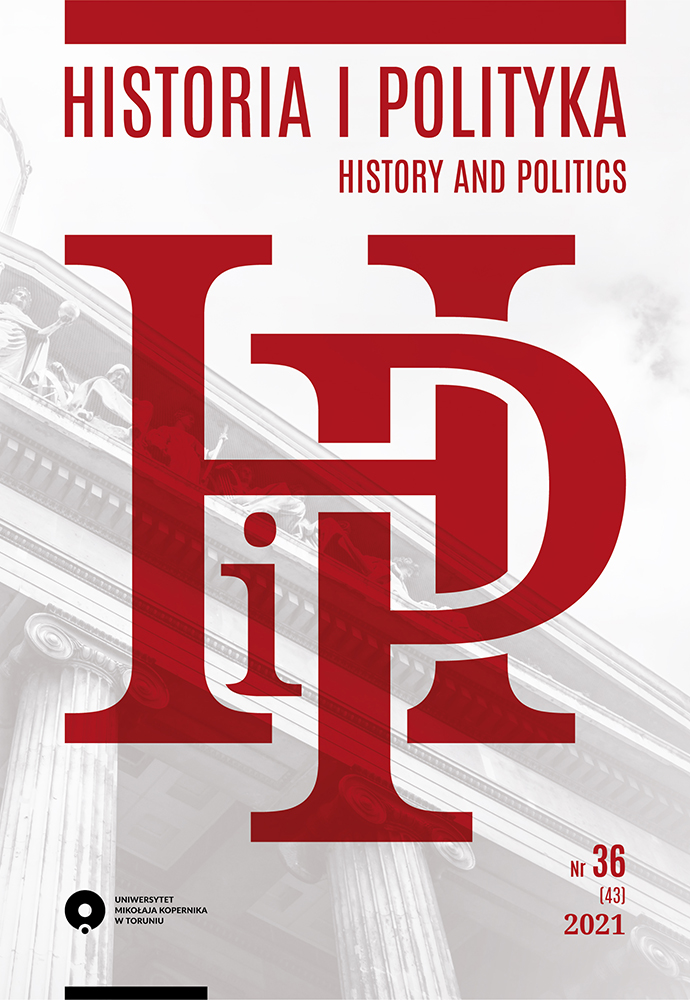Future War: The Russian Perspective
DOI:
https://doi.org/10.12775/HiP.2021.012Słowa kluczowe
Russian Federation, military technology, conflict, future wa, security,Abstrakt
In a multipolar world, military security issues still occupy a key place in the public debate. Military technology is one of the most developing sectors in the world. There is no doubt that the United States and the People’s Republic of China have dominated this sector in recent years. The Russian defense industry is associated with outdated equipment, technology and corruption. Nevertheless, recent conflicts show that the Russian Federation has mastered the elements of information war. “New war” theory was advanced by Mary Kaldor to characterize warfare in the post-Cold War era. According to newest research, nowadays military conflicts employ some elements of both conventional and cybernetic combat, while military operations are supported by domestic and international propaganda. The main goal of this article is to determine what type of conflict is contemporary Russia preparing for and in what ways.
Bibliografia
Baraniec, V. (2018, December 28). «Komsomolka» uznala glavnye sekrety raketnogo kompleksa «Avangard». Retrieved from: https://www.kp.ru/daily/26926.2/3974284/.
Behrendt, P. (2018, July 13). Co dalej z Su-57? Retrieved from: http://www.konflikty.pl/aktualnosci/wiadomosci/co-dalej-z-su-57/.
Clausewitz, C. (2007). On War. Oxford: Oxford University Press.
Collier, P., & Hoeffler, A. (2004). Greed and Grievance in Civil War. Oxford Economic Papers, 56(4), 563–595. DOI: 10.1093/oep/gpf064.
Darczewska, J. (2014). Anatomia rosyjskiej wojny informacyjnej. Operacja krymska – studium przypadku. Warszawa: Ośrodek Studiów Wschodnich im. Marka Karpia. Retrieved from: https://www.osw.waw.pl/sites/default/files/anatomia_rosyjskiej_wojny_informacyjnej.pdf.
Doktrina informatsionnoy bezopasnosti Rossiyskoy Federatsii Utverzhdena Ukazom Prezidenta Rossiyskoy Federatsii ot 5 dekabrya 2016 g. №646 (2016). Retrieved from: http://base.garant.ru/71556224/.
Dura, M. (2018, September 23). Rosja: Wodowanie trzynastoletniego okrętu podwodnego typu „Łada”. Retrieved from: https://www.defence24.pl/rosja-wodowanie-trzynastoletniego-okretu-podwodnego-typu-lada.
Dyner, A.M. (2018, February 8). Nowy rosyjski program zbrojeniowy na lata 2018–2027 – znaczenie dla Polski i NATO. Retrieved from: http://www.polska-zbrojna.pl/home/articleshow/24718?t=Nowy-rosyjski-program-zbrojeniowy-na-lata-2018-2027-znaczenie-dla-Polski-i-NATO.
Emerson, J.B. (2015, June 29). Exposing Russian Disinformation. Retrieved from: http://www.atlanticcouncil.org/blogs/new-atlanticist/exposing-russian-disinformation.
Freedman, L. (2019). Przyszła wojna. Bellona: Warszawa.
Giles, K. (2016). Handbook of Russian Information Warfare. Fellowship Monograph 9. Rome: NATO Defense College.
Harris, S. (2014, March 3). Hack Attack: Russia’s First Targets in Ukraine: Its Cell Phones and Internet Lines. Retrieved from: http://foreignpolicy.com/2014/03/03/hack-attack/.
Hrolenko, A. (2018, March 10). Giperzvukovoe oružie Rossii i kosmičeskoe vozbuždenie Pentagona. Retrieved from: https://lt.sputniknews.ru/20180310/oruzhie-russia-penthagon-5346549.html.
Kaldor, M. (1999). New and Old Wars: Organized Violence in a Global Era. Stanford, CA: Stanford University Press.
Kristensen, H.M., & Korda, M. (2019). Russian Nuclear Forces. Bulletin of the Atomic Scientists, 75(2), 73–84. DOI: 10.1080/00963402.2019.1580891.
Kuczyńska-Zonik, A. (2017). Strategia bezpieczeństwa informacyjnego Federacji Rosyjskiej. In: J. Trubalska, & Ł. Wojciechowski (Eds.). Bezpieczeństwo państwa w cyberprzestrzeni (pp. 97–105). Lublin: WSEI.
Madej, A., & Świeżak, P. (2015). Informacja na temat „Doktryny wojennej Federacji Rosyjskiej”. Bezpieczeństwo Narodowe, III, 177–178.
Malantowicz, A. (2013). Civil War in Syria and the ‘New Wars’ Debate. Amsterdam Law Forum, 5(3), 52–60. DOI: 10.37974/ALF.260.
Malendowski, W. (2017). Doktryna wojenna Federacji Rosyjskiej w XX i XXI wieku. Cele – zadania – kierunki działania. Przegląd Strategiczny, 10, 55–94. DOI: 10.14746/ps.2017.1.4.
Malgin, A. (2018, March 23). Doktrina Gerasimova: seyat’ khaos i razdor. Retrieved from: https://avmalgin.livejournal.com/7598076.html?page=2.
McKew, M.K. (2017, September 7). Doktrina Gerasimova. Retrieved from: https://inosmi.ru/politic/20170907/240217819.html.
Mello, P.A. (2010). In Search of New Wars: The Debate about a Transformation of War. European Journal of International Relations, 16(2), 297–309. DOI: 10.1177/1354066109350053.
Mierzyńska, A. (2018, December 24). Rosjanie się nie cofnęli – cyberwojna z USA trwa! Zagrożenie dla Polski. Retrieved from: https://oko.press/rosjanie-sie-nie-cofneli-cyberwojna-z-usa-trwa-zagrozenie-dla-polski/.
Ministry of Defense of the Russian Federation (2013). Plan deyatel’nosti na 2013–2020 gg [Action Plan for 2013–2020]. Retrieved from: https://mil.ru/mod_activity_plan/constr/lvl/plan.htm.
Münkler, H. (2006). Was ist neu an den neuen Kriegen? Eine Erwiderung auf die Kritiker. In: A. Geis (Ed.). Den Krieg überdenken. Kriegsbegriffe und Kriegstheorien in der Kontroverse (pp. 133–150). Baden-Baden: Nomos.
Novyj «Filin» Rosteha oslepit pravonarušitelej (2018, December 20). Retrieved from: https://rostec.ru/news/novyy-filin-rostekha-oslepit-pravonarushiteley/.
Polyakova, A. (2019, June 18). Five Years after the Revolution of Dignity: Ukraine’s Progress and Russia’s Malign Activities. Retrieved from: https://www.brookings.edu/testimonies/five-years-after-the-revolution-of-dignity-ukraines-progress-russias-malign-activities/.
Radin, A., Davis, L.E., Geist, E., Han, E., Massicot, D., Povlock, M., Reach, C., Boston, S., Charap, S., Mackenzie, M., et al. (2019). The Future of the Russian Military: Russia’s Ground Combat Capabilities and Implications for U.S.-Russia Competition. Santa Monica: RAND Corporation.
Ramesh, G. (2019, July 10). Russia Continues Information Warfare. Retrieved from: https://www.afcea.org/content/russia-continues-information-warfare.
Russia Sets Its Arms Priorities (2006, January 18). Retrieved from: http://www.rferl.org/content/article/1143555.html.
The Military Balance (2018). London: International Institute for Strategic Studies.
Thomas, T. (2004). Russia’s Reflexive Control Theory and the Military. Journal of Slavic Military Studies, 17(2), 237–256. DOI: 10.1080/13518040490450529.
«Voron 777-1» smozhet ne tol’ko letat’, no i strelyat’ (2017, June 16). Retrieved from: https://tvzvezda.ru/news/opk/content/201706161625-5ddc.htm.
Voyennaya doktrina Rossiyskoy Federatsii (2014). Retrieved from: http://news.kremlin.ru/media/events/files/41d527556bec8deb3530.pdf.
W Minoborony nazvali čislo zakuplennyh tankov «Armata» (2016, April 19). Retrieved from: https://lenta.ru/news/2016/04/19/armata_100/.
Pobrania
Opublikowane
Jak cytować
Numer
Dział
Licencja
Prawa autorskie (c) 2021 Natalia Olszanecka

Utwór dostępny jest na licencji Creative Commons Uznanie autorstwa – Bez utworów zależnych 4.0 Międzynarodowe.
Uniwersytet Mikołaja Kopernika w Toruniu respektuje prawo do prywatności i ochrony danych osobowych autorów.
Dane autorów nie są wykorzystywane w celach handlowych i marketingowych. Redaktorzy i recenzenci są zobowiązani do zachowania w poufności wszelkich informacji związanych ze złożonymi do redakcji tekstami.
Autor, zgłaszając swój tekst wyraża zgodę na wszystkie warunki i zapisy umowy licencyjnej (określającej prawa autorskie) z Uniwersytetem Mikołaja Kopernika w Toruniu.
Statystyki
Liczba wyświetleń i pobrań: 777
Liczba cytowań: 0



